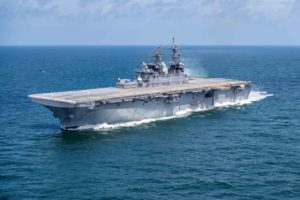
The recent $56 million Ship Self-Defense System (SSDS) combat system engineering contract win by Lockheed Martin [LMT] is helping the Navy work toward the future integrated combat system, a company official said.
Last week’s award makes the company the SSDS Combat System Engineering Agent (CSEA), while it already serves as CSEA for the Aegis combat system. Here, Lockheed Martin will develop, integrate, and maintain combat system capabilities for the self-defense system of non-Aegis ships including carriers and amphibious vessels (Defense Daily, Aug. 15).
The award, in conjunction with Lockheed Martin’s similar work on Aegis ships, gives the Navy “the opportunity to start to converge towards a level of commonality for the future integrated combat system, and it gives them an opportunity to build capability once and use it multiple times across different ships,” Rich Calabrese, company program director for Surface Navy Mission Systems at Lockheed Martin, told Defense Daily in an interview.
Meanwhile, Lockheed Martin takes the award as a confirmation of the Navy’s trust in using them as a CSEA and their expertise across various domains and missions.
“We’re really excited about being able to apply the combat system knowledge and the mission knowledge that we have been applying across the common source library to the surface combatants – to the large decks, the carriers and the amphibs,” Calabrese said.
The Navy is pushing to create a unified combat system among surface ships that focuses on shared software that can run various systems. Aegis destroyers and cruisers, SSDS, and both Littoral Combat Ship versions all have separate combat systems. Some systems are even separated from a ship’s main combat system.
Calabrese underscored the Navy has said this new integrated system will be based on the Common Source Library, developed by Lockheed Martin. Lockheed Martin brings “the ability to look across the SSDS and Aegis programs, LCS and frigate and essentially, call it best of breed solutions, that can be brought to bear at what ultimately end up in what they would call the integrated combat system.”
Lockheed Martin is seeing it working on parallel evolution of the SDSS and Aegis systems going forward. Then, as both systems face re-architectures, “we’ll be looking at how do we re-architect them with a few tools…and the ability to apply that common solution across all of the ships that will ultimately have the integrated combat system as part of their solution,” Calabrese said.
He noted next in this process the Navy is going through an acquisition for the CSEA for the surface combatants overall, which the company is certainly interested in.
Lockheed Martin is almost already acting as surface combatant CSEA because it is working as CSEA for the Aegis, LCS, frigate, Coast Guard, and now SSDS ships.
“I think it is an unparalleled span of system engineering knowledge & combat system knowledge that we bring to bear to apply to meet the role that the Navy has for a surface combatant CSEA agent,” Calabrese said.
The company is “just really excited” by the opportunity to work with the Navy and help them get service-defined levels of commonality built across platforms.
Calabrese emphasize they look forward to working with the Navy to define levels of commonality, at what speed, and how to leverage company products in the portfolio.
“We’re prepared to work with them to essentially deliver what makes sense in terms of the total amount of commonality that we want and they want to deliver.”